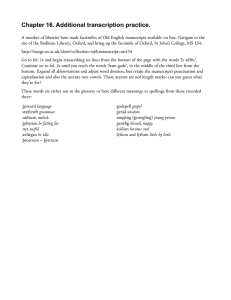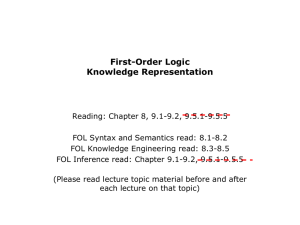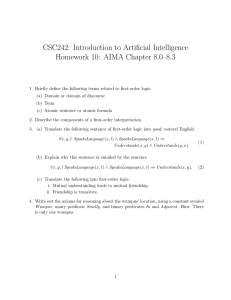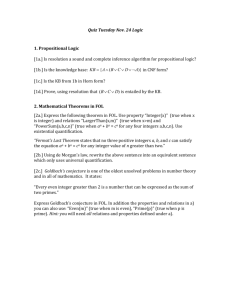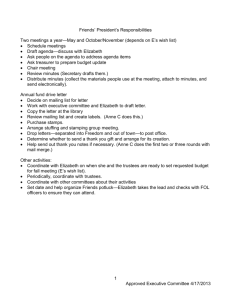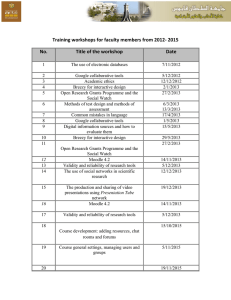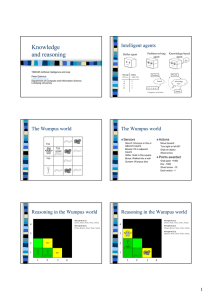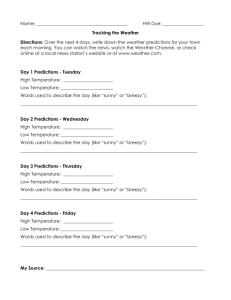AI chap7
advertisement
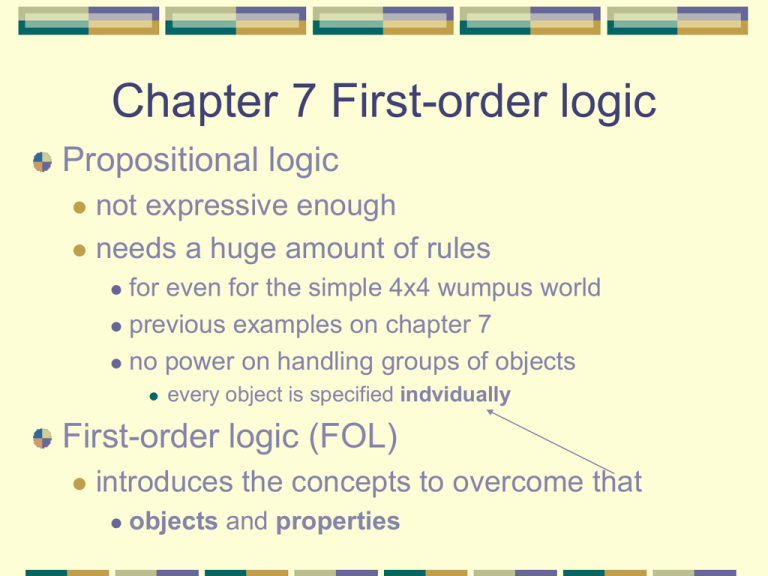
Chapter 7 First-order logic
Propositional logic
not expressive enough
needs a huge amount of rules
for even for the simple 4x4 wumpus world
previous examples on chapter 7
no power on handling groups of objects
every object is specified indvidually
First-order logic (FOL)
introduces the concepts to overcome that
objects and properties
Why we need logic?
Natural language?
the expressive power – high but ambiguous
can it be used as a representation language
in AI?
serves as a medium of communication
rather than pure representation
since 1 syntax too many (hidden) semantics
For logic?
it’s like a function: one-to-one mapping.
New concepts
Relations
are the links among objects
can be functions – only one output for a given input
Examples:
Objects: people, houses, number, colors, baseball,
centuries
Relations: either unary (property) or n-ary
unary: tall, large, small, red, round, prime, boring
n-ary: brother of, greater than, part of, inside, after, is
Functions: father of, best friend, one more than
Almost any fact (assertion) can be thought
of a combination of
objects
and properties or relations
“One plus two equals three”
Objects: one, two, three, one plus two
Relation: equals
Function: plus
A name of the object
obtained by applying the
function plus to the
objects one and two
“Squares neighboring the wumpus are
smelly.”
Objects: Squares, wumpus
Not a function because
Property: smelly
many squares may satisfy
Relation: neighboring
the constraints, but there
is only one three
FOL is important
almost any of our concept/knowledge
can be expressed as FOL
Pros & Cons of FOL
Drawback
first-order logic doesn't have the things
Categories / Classification
Time (Temporal Logic)
Events
Advantage
it can express
anything that can be programmed
Prolog
Difference of FOL and PL
PL
consider the facts: True or False
use compositionality to see
whether the sentence is true or false
FOL
consider the RELATIONS with OBJECTS:
True or False
also use compositionality
Models for FOL
What is a model?
in PL: A B => C
then how many possible combinations?
this set of truth values = a model for this world
only True or False exists
in FOL, a model contains more.
objects
domain of an FOL model
= set of objects (domain elements) it contains
There are five objects in this model
two binary relations
three unary relations
one unary function: left-leg
Formally speaking, relation is
a set of tuples of objects that are related
e.g., for relation brother, it is the set
{ < Richard, King John>, <King John, Richard>}
Strictly speaking,
the functions used in FOL must be total functions
i.e., a function returns a value for every input tuple
constituted by the domain elements
e.g., brother:X Y, any body must have a brother?
left_leg:X Y, anything must have a left leg?
left_leg(Leftleg1) = Leftleg2?
Syntax of FOL
Terms
a logical expression of objects
Terms =
constant symbols (1, a, b, peter)
variables (X, Y, Human)
and function symbols (fatherof(peter), plus(1,2))
Atomic sentences
the facts in Prolog
= Predicate symbol + Terms
= Relation + Objects
e.g., brother(Richard, John).
married(Father(Richard), Mother(John))
Complex sentences
multiple atomic sentences combined with
logical connectives
Example:
Brother(Richard, John) Brother(John, Richard)
Older(John, 30) Younger(John, 30)
Quantifiers
Quantifiers
For expressing properties of
entire collection of objects – projection of a subset
Universal quantification ()
Meaning all,
reading as “For all”
Example: “All Kings are Persons”
x King(x) Person(x)
If X is a King, then X is a Person
•called a variable,
•lowercase
•if it’s a constant,
•ground term
Here x King(x) Person(x) is true
if x = any domain element,
and the sentence is still true.
x Richard
x King John
x Richard’s left leg
x John’s left leg
x the crown
the above list is called the extended
interpretation
By applying this list, what we have?
Are they true in the model?
Yes!!!! (but only for interpretation)
from the table of implication ( =>)
whenever the premise is false
the result is true, regardless of the conclusion
So, Universal quantifier
asserts a list of sentences (reduce our work!)
Existential quantification ()
Meaning some
reading as “There exist” or “For some”
Example
x Crown(x) OnHead(x, John)
Here, we can see
=> is the natural connective with
while with
if with , too strong, if => with , too
weak
Nested Quantifiers
When using multiple quantifiers, e.g.,
x y Brother(x, y) => Sibling (x, y)
we can write x, y instead of separate ones
x y Loves (x, y)
meaning?
Everybody x loves somebody y
then y x Loves (x, y)?
any difference?
Somebody y, whom is loved by
everybody x.
Problem?
Quantifiers are not commutative
The order cannot be interchanged
Similar to a query
If we want to specify the precedence,
we should use ( )
e.g., y ( x Loves (x, y) )
Connections between and
is a conjunction over the universe
While is a disjunction
De Morgan rules can apply to them:
x P x P
x P x P
x P x P
x P x P
So, only one of the or is necessary
we don’t need both
Equality
Equality is represented as
“=”
instead of a predicate
Example: FatherOf(John) = Henry
To ensure two objects are not the same
negation with equality is used
E.g., x,y Sister(Felix, x) Sister(Felix, y)
(x = y)
without that, what is the
meaning?
The uniqueness quantifier !
just specifies
One or more different objects
! is used to specify
a unique one object
Example: “There is only one king”
!x King(x)
Or x King(x) y King(y) (x = y)
If X is a King & Y is a King then X must be Y
Using first-order logic
domain
a section of the world
about which we wish to express some knowledge
database, networking, architecture, etc.
The followings are the examples
The kinship domain
The domain of numbers, sets and lists
The kinship domain
Also called family relationships domain
The objects in the domain are people
The properties of the objects include
Gender
Age
Height, …
The relations are:
parenthood, brotherhood, marriage, …
Some Examples
m,c Mother(c)=m Female(m) Parent(m,c)
w,h Husband(h,w) Male(h) Spouse(h,w)
Disjoint categories:
x Male(x) Female(x)
Inverse relations:
p,c Parent(p,c) Child(c,p)
g,c Grandparent(g,c) p Parent(g,p)
Parent(p,c)
x,y Sibling(x,y) x≠y p Parent(p,x)
Parent(p,y)
we can have many more axioms like these.
this will be one of your exercises in PJ.3
Must the Male, Female, Parent be
the set of primitive predicates?
Of course, not.
We may use other predicates as the
primitive set
And also, in some domains
we have no clearly identifiable basic set
The domain of numbers
Here is the theory of natural numbers
to check if a number is natural
NatNum
a constant symbol (basis)
0
a function symbol S, meaning successor
NatNum(0).
n NatNum(n) => NatNum(S(n)).
After that, we define constraints about
the function S
n 0 ≠ S(n)
m, n m ≠ n => S(m) ≠ S(n)
addition of natural numbers
m NatNum(m) => ( + (m, 0) = m )
m, n NatNum(m) NatNum(n) =>
+(S(m) , n) = S(+(m,n))
The domain of sets
We want to represent individual sets,
including empty set.
What we need?
a way to building up a set
by adding an element to a set (adjoining)
take union of two sets
take intersection of two sets
Checking?
membership of an element
whether it is a set or other objects
Hence we want to define the followings
Constant symbol:
{}
Predicates:
Set, Member, Subset
Functions:
Adjoining, Union, Intersection
The domain of lists
Lists are similar to sets
difference?
Lists are ordered
An element can appear more than once
Here is the summary of their difference
Ø ={ }
[] = Nil
{x} = {x | { } }
[x] = Cons(x, Nil)
{x, y} = {x | {y | { } } }
[x,y] = Cons(x, Cons(y, Nil))
{x, y|s} = {x | { y | s} }, s is a set
[x,y|l] = Cons(x, Cons(y, l))
r s = Union(r, s)
r s = Intersection(r, s)
x s = Member(x, s)
r s = Subset(r, s)
The wumpus world
Recall the wumpus agent receives
a percept vector [S, B, G, BUMP, S]
As the percept is time critical,
we add an integer as the time step
percept([S, B, G, None, None], 5)
S, B, G, etc. are constant symbols
The actions in wumpus world
Turn(Right), Turn(Left), Forward, …
we want to pick up a best action for any time
To choose a best action, we may ask
a BestAction(a, 5), for example
the result may be a = Grab (a Glitter!!)
But is it some straightforward?
we have to first tell KB what happens!!
s,b,u,c,t Percept([s, Breeze, g, m, c], t) Breeze(t)
s,b,u,c,t Percept([s, b, Glitter, m, c], t) Glitter(t)
and so on.
but it’s not enough
since we need to define additional rules
t Glitter(t) => BestAction(Grab, t)
and so on.
Defining environments
Objects in the environment
squares
pits
the wumpus
For any square,
x, y, a, b Adjacent([ x, y ], [a, b])
[a, b] {[ x 1, y ], [ x 1, y ], [ x, y 1], [ x, y 1]}
named as Square1,2 and so on.
for adjacent squares, we have to define them
pair by pair!!
hence using a rule is much better
For the pits,
we don’t need name them individually
we just need to use a unary predicate
Pit(S), to indicate a square has a pit or not
For the wumpus,
there exists only one
it lives only in exactly one square
so, we may use Home(Wumpus) to name
the square
where Wumpus is a constant and Home a
function
As the agent moves
it changes over time
we use At(Agent, s, t) to specify
at a time step, Agent is at s
For the properties of the environment
it is constant over time.
e.g., a square is breezy (has a breeze)
s, t At(Agent, s, t) Breeze(t) =>
Breezy(s)
The same for smelly (has a stench).
Diagnostic rules
For a given percept, what does it mean?
what results can be concluded?
e.g., if a square is breezy, then what?
implies “some adjacent square has a pit!”
s Breezy(s) => r Adjacent(r, s) Pit(r)
For the reverse direction, is it true?
yes, so we have
s Breezy(s) <=> r Adjacent(r, s) Pit(r)
Causal rules
For a given result, what facts can be
deduced?
if r is a pit, then?
all adjacent squares of r are breezy
r Pit(r) => [s Adjacent(r, s) Breezy(s)]
if all squares adjacent to a square s are not
pits, then s is not breezy
s [r Adjacent(r, s) => Pit(r)] => Breezy(s)
Basically, these rules are equivalent to previous
bidirectional rule
Conclusion
the facts or world description
Whichever kind representation
if the axioms correctly and completely
describe the way the world works
and the way the percepts are produced
then any complete logical inference
procedure
successor function
will infer the strongest possible description
of the world state
given the available percepts

